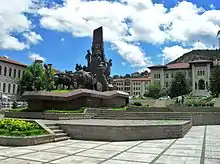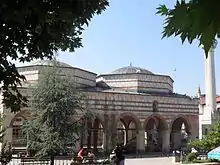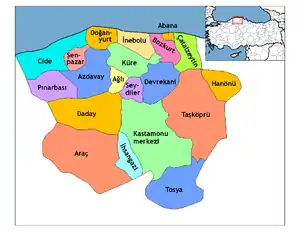Kastamonu
Kastamonu is the capital district of the Kastamonu Province, Turkey. According to the 2000 census, population of the district is 102,059 of which 64,606 live in the urban center of Kastamonu.[3][4] (Population of the urban center in 2010 is 91,012.[5]) The district covers an area of 1,834 km2 (708 sq mi),[6] and the town lies at an elevation of 904 m (2,966 ft). It is located to the south of the province.
Kastamonu | |
|---|---|
 | |
 Kastamonu  Kastamonu  Kastamonu | |
| Coordinates: 41°22′35″N 33°46′35″E | |
| Country | Turkey |
| Province | Kastamonu Province |
| Government | |
| • Mayor | Op. Dr. R. Galip Vidinlioğlu (MHP) (AKP) |
| Area | |
| • District | 1,834.04 km2 (708.13 sq mi) |
| Population (2012)[2] | |
| • Urban | 96,217 |
| • District | 128,537 |
| • District density | 70/km2 (180/sq mi) |
| Climate | Cfb |
| Website | www.kastamonu.bel.tr |
History

.jpg.webp)


The city is believed to have been founded in the 18th century BC. The town was known as Timonion (Τιμόνιον in Greek) during the Roman period.
The change of name of the town dates to the 10th century AD. Manuel Erotikos Komnenos, a Thracian soldier who became a prominent general and the father of the Byzantine emperor Isaac I Komnenos, was given lands around Kastamonu by Emperor Basil II and built a fortress there named Kastra Komnenon (Κάστρα Κομνηνών). Manuel came to the notice of Basil II because of his defence, in 978, of Nicaea against the rebel Bardas Skleros.[7] The name Kastra Komnenon was shortened to Kastamone, and later turkified to Kastamoni and Kastamonu.
Ibn Battuta visited the city, noting it as "one of the largest and finest cities, where commodities are abundant and prices low." He stayed here forty days.[8]
The famous sufi saint of the city is Shaykh Shaban Wali (Şaban-ı Veli in Turkish, d. 976 AH/1569 CE).[9][10]
The Dress Code Revolution of Kemal Atatürk started on August 23, 1925 at Kastamonu. Atatürk made his historical speech concerning the "Hat and Dress Revolution" during his visit to Kastamonu in 1925 in the Republican People's Party building.[11] The building is now used as the Archeological Museum of Kastamonu. The possessions used by Atatürk in his Kastamonu visit are also exhibited in the museum.
Cuisine
Typical country fare in Kastamonu includes a quick rose jam made with sugared water, citric acid and gül mayası - the latter is a preparation of culinary-grade rose petals with sugar and citric acid that preserves them and brings out their flavor and fragrance. Homemade hot sauce is made by simmering grated tomato, garlic, Turkish red pepper, hot peppers, sunflower oil, salt and pepper on the stove. Sweet katmer is made by preparing a simple unleavened dough of flour, salt and water that is smeared with a tahini and sunflower oil mixture as it is folded.[12]
Breakfast might include farm made cheese, olives, pekmez, fried potatoes, rose jam homemade hot sauce, eggs served hot in the pan (called sahanda yumurta), folded unleavened bread called katmer, fresh farm milk and black tea.[12]
A speciality of Taşköprü, Kastamonu is freshly slaughtered whole lamb slow-cooked over the glowing embers of wood in a sealed, airtight "well" — this regional specialty is called kuyu kebab in Turkish. A little water added to a tray ensures that steam keeps the meat moist throughout the cooking process.[12]
Education
Kastamonu is home to Kastamonu University, which was established in 2006 by incorporating existing colleges, schools, and institutes that were previously under Ankara University and Gazi University. Notable high schools in Kastamonu are: Abdurrahman Paşa Lisesi, also known as Kastamonu Lisesi, the first modern high school that was established in Anatolia in late Ottoman Empire. Kastamonu Mustafa Kaya Lisesi, an Anatolian high school, one of the most successful high schools in Turkey outside Istanbul, Ankara and İzmir.
Climate
Kastamonu has a humid continental climate (Köppen: Dfb) using the 32 degree isotherm, with cold winters and warm summers. The average annual precipitation is evenly distributed throughout the year, with spring being the wettest season.
| Climate data for Kastamonu (1930–2017) | |||||||||||||
|---|---|---|---|---|---|---|---|---|---|---|---|---|---|
| Month | Jan | Feb | Mar | Apr | May | Jun | Jul | Aug | Sep | Oct | Nov | Dec | Year |
| Record high °C (°F) | 17.3 (63.1) |
21.1 (70.0) |
27.8 (82.0) |
31.4 (88.5) |
35.1 (95.2) |
37.5 (99.5) |
42.2 (108.0) |
40.2 (104.4) |
36.5 (97.7) |
32.5 (90.5) |
24.7 (76.5) |
21.1 (70.0) |
42.2 (108.0) |
| Average high °C (°F) | 3.1 (37.6) |
6.0 (42.8) |
10.8 (51.4) |
16.5 (61.7) |
21.1 (70.0) |
24.6 (76.3) |
27.8 (82.0) |
28.0 (82.4) |
23.8 (74.8) |
18.0 (64.4) |
10.9 (51.6) |
4.7 (40.5) |
16.3 (61.3) |
| Daily mean °C (°F) | −1.1 (30.0) |
0.7 (33.3) |
4.3 (39.7) |
9.5 (49.1) |
14.2 (57.6) |
17.6 (63.7) |
20.3 (68.5) |
20.0 (68.0) |
15.7 (60.3) |
10.7 (51.3) |
5.1 (41.2) |
0.8 (33.4) |
9.8 (49.6) |
| Average low °C (°F) | −4.6 (23.7) |
−3.5 (25.7) |
−0.9 (30.4) |
3.3 (37.9) |
7.5 (45.5) |
10.4 (50.7) |
12.3 (54.1) |
12.2 (54.0) |
8.8 (47.8) |
5.1 (41.2) |
0.8 (33.4) |
−2.4 (27.7) |
4.1 (39.4) |
| Record low °C (°F) | −26.9 (−16.4) |
−22.3 (−8.1) |
−19.7 (−3.5) |
−8.5 (16.7) |
−3.6 (25.5) |
0.2 (32.4) |
3.8 (38.8) |
0.9 (33.6) |
−1.5 (29.3) |
−7.5 (18.5) |
−19.3 (−2.7) |
−23.7 (−10.7) |
−26.9 (−16.4) |
| Average precipitation mm (inches) | 29.9 (1.18) |
27.0 (1.06) |
34.5 (1.36) |
51.8 (2.04) |
74.1 (2.92) |
71.4 (2.81) |
31.8 (1.25) |
31.2 (1.23) |
30.1 (1.19) |
35.3 (1.39) |
29.1 (1.15) |
33.8 (1.33) |
480.0 (18.90) |
| Average precipitation days | 12.4 | 11.3 | 12.0 | 12.9 | 14.5 | 11.8 | 6.2 | 5.7 | 6.5 | 9.1 | 9.6 | 11.9 | 123.9 |
| Mean monthly sunshine hours | 71.3 | 101.7 | 142.6 | 174.0 | 226.3 | 258.0 | 306.9 | 294.5 | 222.0 | 173.6 | 114.0 | 62.0 | 2,146.9 |
| Mean daily sunshine hours | 2.3 | 3.6 | 4.6 | 5.8 | 7.3 | 8.6 | 9.9 | 9.5 | 7.4 | 5.6 | 3.8 | 2.0 | 5.9 |
| Source: Turkish State Meteorological Service[14] | |||||||||||||
Transport

The main bus station has bus links to most major Turkish cities. Kastamonu Airport is active. Kastamonu is also the main railroad endpoint for the West Black Sea region.
Notable natives
- Latifî (1491-1582), Ottoman poet
- Iovan Tsaous (Yiannis Eitziridis) (1893–1942), Greek musician and composer
- Oğuz Atay (1934–1977), novelist
- Rıfat Ilgaz (1911–1993), novelist
- Halit Akmansü (1883–1923), military officer in the Ottoman and Turkish armies
Gallery
_-_panoramio.jpg.webp) City center
City center Kastamonu school building
Kastamonu school building Kastamonu University
Kastamonu University Historic Turkish houses
Historic Turkish houses Tomb
Tomb










See also
- List of clock towers - Kastamonu has its own Ottoman clock tower (1885)
Notes
- "Area of regions (including lakes), km²". Regional Statistics Database. Turkish Statistical Institute. 2002. Retrieved 2013-03-05.
- "Population of province/district centers and towns/villages by districts - 2012". Address Based Population Registration System (ABPRS) Database. Turkish Statistical Institute. Retrieved 2013-02-27.
- Turkish Statistical Institute. "Census 2000, Key statistics for urban areas of Turkey" (in Turkish). Archived from the original (XLS) on September 27, 2007. Retrieved 2008-11-17.
- GeoHive. "Statistical information on Turkey's administrative units". Retrieved 2008-11-22.
- Statistical Institute
- Statoids. "Statistical information on districts of Turkey". Retrieved 2008-11-22.
- Runciman, pp. 54-55
- Battutah, Ibn (2002). The Travels of Ibn Battutah. London: Picador. p. 117. ISBN 9780330418799.
- "ŞÂBÂN-ı VELÎ - TDV İslâm Ansiklopedisi". islamansiklopedisi.org.tr (in Turkish). Retrieved 2020-09-11.
- Laluask: Şaban-ı Veli
- İğdemir, Uluğ (1963). Atatürk. Mango, Andrew (trans.). Ankara: Turkish National Commission for UNESCO. pp. 165–170. OCLC 75604149.
- Lezzet Haritası - Kastamonu /29 Kasım. Show TV. Retrieved 2018-07-30.
- Prothero, G.W. (1920). Anatolia. London: H.M. Stationery Office. p. 106.
- "Resmi İstatistikler: İllerimize Ait Genel İstatistik Verileri" (in Turkish). Turkish State Meteorological Service. Archived from the original on 22 February 2019. Retrieved 22 February 2019.
References
- Falling Rain Genomics, Inc. "Geographical information on Kastamonu, Turkey". Retrieved 2008-11-14.
- Runciman, Steven (1951) A History of the Crusades, Vol. I: The First Crusade, Cambridge University Press.
Further reading
External links
| Wikivoyage has a travel guide for Kastamonu. |
| Wikimedia Commons has media related to Kastamonu. |
